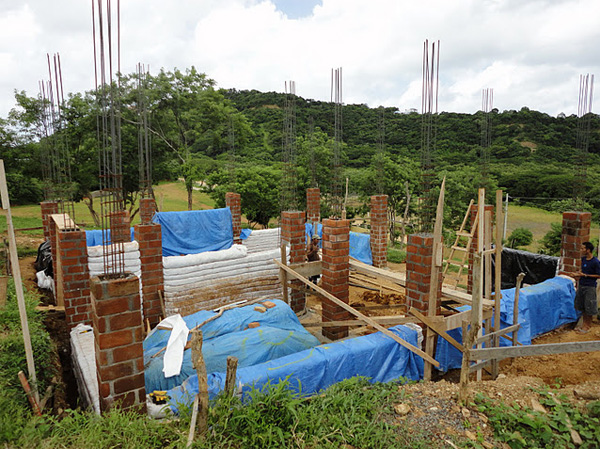
“In a sense, virtually all buildings are hybrids of one sort or another. Most modern buildings employ a wide range of materials, some “natural” some not. A strawbale house, for instance, is most likely a hybrid of strawbales and conventional wood framing. Unless the building is a dome or vault, the roof is likely framed with wood or steel. Our domed home is a hybrid of earthbag and papercrete materials. I know of a fine circular home that was minimally framed with 2X4 studs and then strawbales set on their ends provided the insulation.

I am completely in favor of using hybrid building concepts, because it frees the mind to use whatever material or technique is appropriate for any given application or aesthetic. Cob is a wonderful material for creating curved, sensuous forms; adobe and rammed earth are great for thick, fairly straight walls that serve as thermal mass; earthbags can be used for either curved or straight walls that can be either insulation or thermal mass, depending on what they are filled with; straw bales are best used for straight, thick, insulating walls; cordwood construction provides both thermal mass and insulation, and is easiest when forming straight walls; old tires make great retaining walls, or even foundations for other materials; papercrete is primarily an insulating material that can be used as a plaster, or a structural material and is extremely malleable; rocks provide wonderful thermal mass and can be stacked in a variety of shapes.

I suggest that you take advantage of the materials that can be found nearby that do the job required and appeal to your fancy. If it weren’t for building codes, the only rules for how you build would be the laws of physics and mother nature. So, go for it when you can!”
Source: Green Home Building.com
Image source: Building with Awareness.com
Image source: Casa de Tierra, http://www.casadetierra.com/projects/casas_el_encanto.html
Image source: Info Barrel

Interesting and informative article from you, Owen. Have to agree with you and Dustin when it comes to picking materials for a house. Too many people only look at aesthetic and not in the practical sense of building a house.
Owen, I am wondering if you would mind answering a question or two? In earth-bag construction of domes, do you have to build the fan bag arches? I have seen in a book that you can cut them out as you build, would this be as structurally sound as the form with the fan bags? I have also seen where some people just have their form, but, instead of using fan bags, they jut lay their rows normally until they have their form covered. Or, do you even have to have the arches?
You can do it all three ways. If you don’t do the fan bags, it would be good to stabilize the bags or tubes above the arch just in case. And, of course, be sure your mix turns into a solid block after drying.
Dustin, I agree about an asphalt roof in a desert environment.
“…use whatever material or technique is appropriate for any given application or aesthetic.”
Or environment. There is a tragically huge quantity of structures that are totally inappropriate for their climate.
Asphalt roof in the desert, really? You ever stand barefoot on a road in the desert? I thought you wanted your house to be not a bajillion degrees? [willfully inarticulate for emphasis]
What asphalt roof are you talking about? People leave comments like this without referencing what they’re talking about. And then you leave a remark like “have I ever stood barefoot on a road in the desert”. Geez.
Look at the city of Phoenix, AZ on Google Maps. Asphalt roofs everywhere… Dumb. But do something rational and you’re a weirdo and have to contend with the code nazis…